Public Health Strategies: Addressing Health Inequalities Analysis
VerifiedAdded on 2023/06/14
|8
|2074
|490
Essay
AI Summary
This essay delves into public health strategies, emphasizing the profound impact of social determinants on health outcomes, drawing significantly from the work of Marmot. It critically analyzes two interventions implemented to combat health inequalities at national and local levels, examining the rationale behind their introduction and evaluating their effectiveness. The essay highlights how factors like social class, stress, poverty, employment, addiction, and access to nutritious food significantly influence health. Marmot's proposed multisector approach to reduce health inequalities is discussed, alongside his six policy objectives aimed at improving health standards and opportunities for all. The essay further explores specific interventions, such as positive parenting programs and initiatives to reduce youth unemployment, assessing their contributions to promoting social and emotional development and overall health equity, ultimately underscoring the ongoing need for comprehensive efforts to ensure equitable access to health services, especially for vulnerable populations.
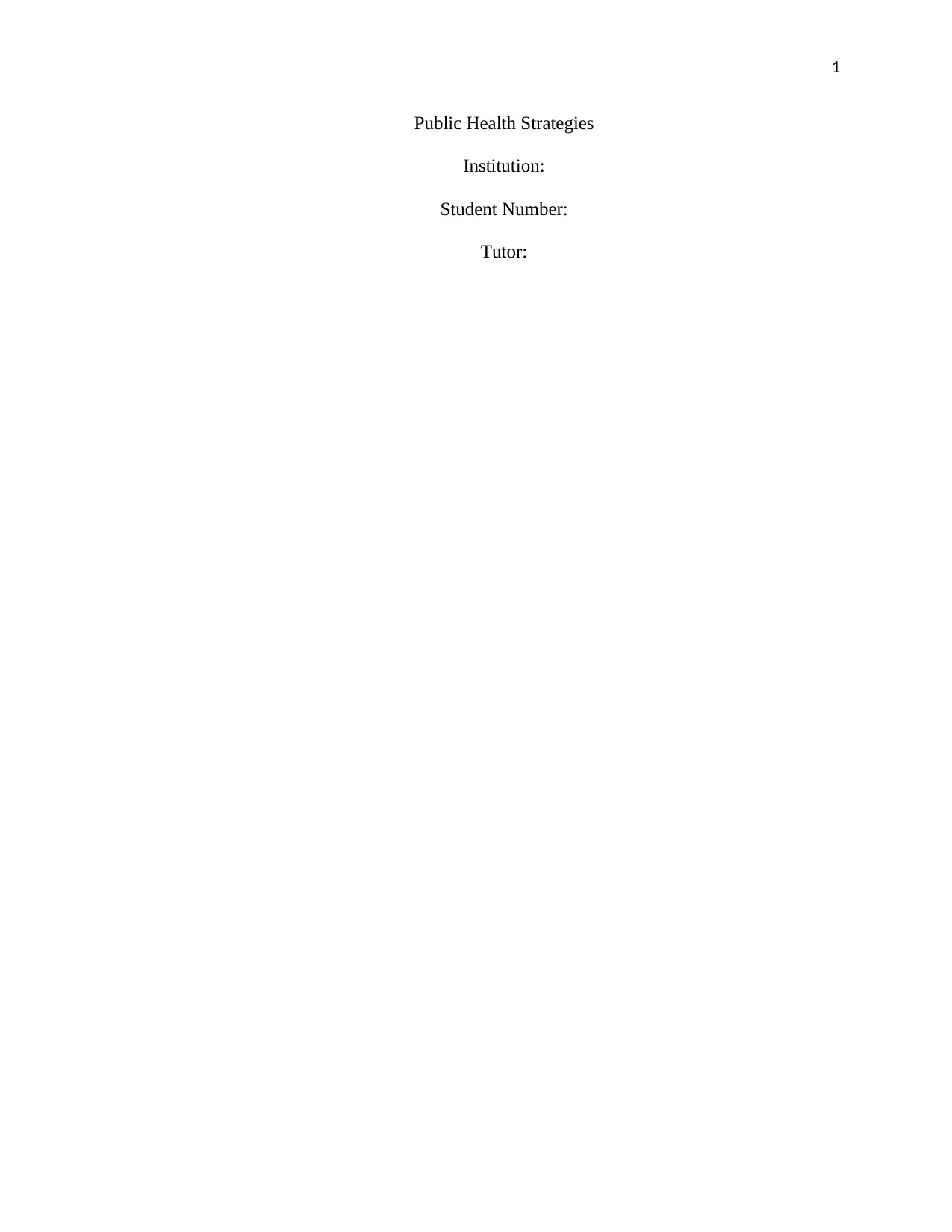
1
Public Health Strategies
Institution:
Student Number:
Tutor:
Public Health Strategies
Institution:
Student Number:
Tutor:
Paraphrase This Document
Need a fresh take? Get an instant paraphrase of this document with our AI Paraphraser
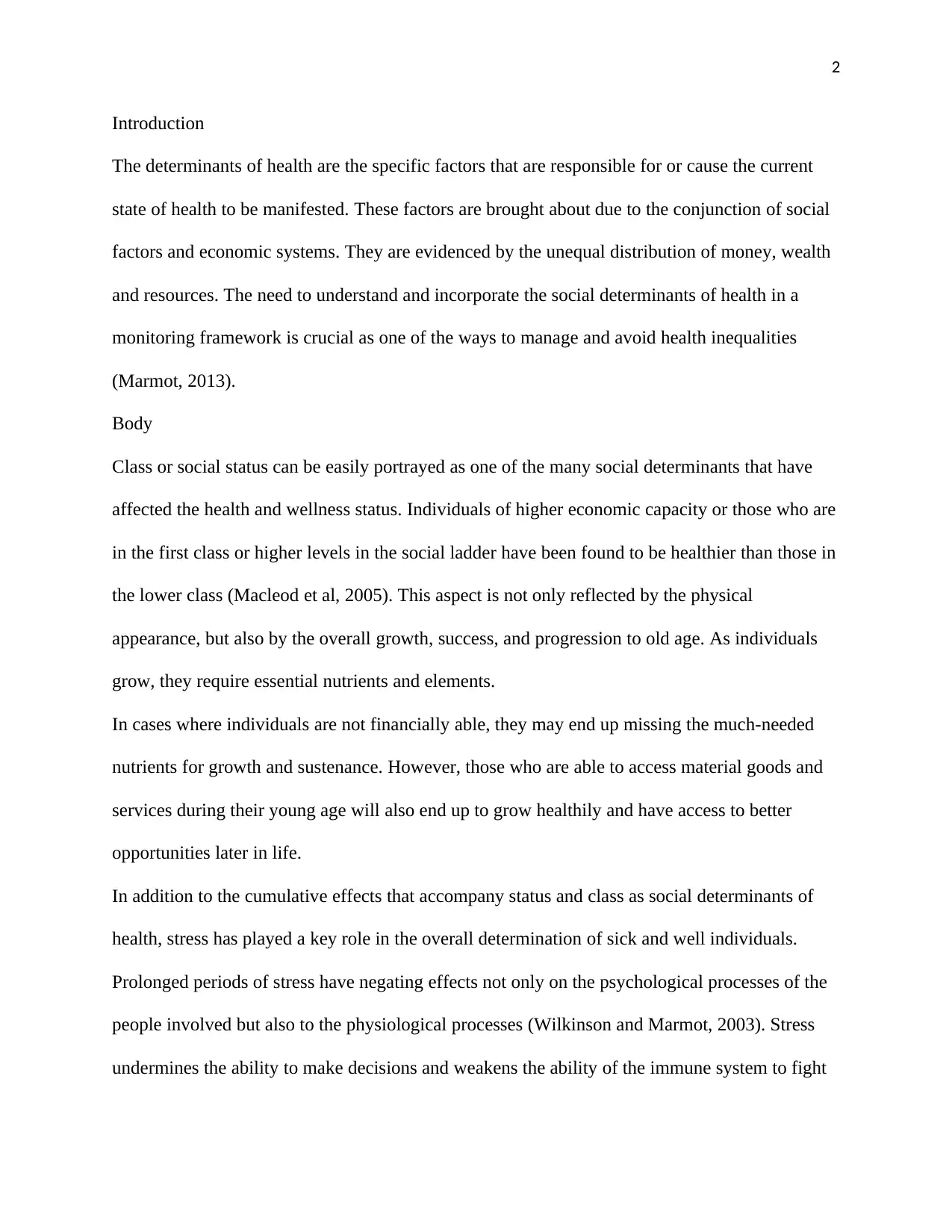
2
Introduction
The determinants of health are the specific factors that are responsible for or cause the current
state of health to be manifested. These factors are brought about due to the conjunction of social
factors and economic systems. They are evidenced by the unequal distribution of money, wealth
and resources. The need to understand and incorporate the social determinants of health in a
monitoring framework is crucial as one of the ways to manage and avoid health inequalities
(Marmot, 2013).
Body
Class or social status can be easily portrayed as one of the many social determinants that have
affected the health and wellness status. Individuals of higher economic capacity or those who are
in the first class or higher levels in the social ladder have been found to be healthier than those in
the lower class (Macleod et al, 2005). This aspect is not only reflected by the physical
appearance, but also by the overall growth, success, and progression to old age. As individuals
grow, they require essential nutrients and elements.
In cases where individuals are not financially able, they may end up missing the much-needed
nutrients for growth and sustenance. However, those who are able to access material goods and
services during their young age will also end up to grow healthily and have access to better
opportunities later in life.
In addition to the cumulative effects that accompany status and class as social determinants of
health, stress has played a key role in the overall determination of sick and well individuals.
Prolonged periods of stress have negating effects not only on the psychological processes of the
people involved but also to the physiological processes (Wilkinson and Marmot, 2003). Stress
undermines the ability to make decisions and weakens the ability of the immune system to fight
Introduction
The determinants of health are the specific factors that are responsible for or cause the current
state of health to be manifested. These factors are brought about due to the conjunction of social
factors and economic systems. They are evidenced by the unequal distribution of money, wealth
and resources. The need to understand and incorporate the social determinants of health in a
monitoring framework is crucial as one of the ways to manage and avoid health inequalities
(Marmot, 2013).
Body
Class or social status can be easily portrayed as one of the many social determinants that have
affected the health and wellness status. Individuals of higher economic capacity or those who are
in the first class or higher levels in the social ladder have been found to be healthier than those in
the lower class (Macleod et al, 2005). This aspect is not only reflected by the physical
appearance, but also by the overall growth, success, and progression to old age. As individuals
grow, they require essential nutrients and elements.
In cases where individuals are not financially able, they may end up missing the much-needed
nutrients for growth and sustenance. However, those who are able to access material goods and
services during their young age will also end up to grow healthily and have access to better
opportunities later in life.
In addition to the cumulative effects that accompany status and class as social determinants of
health, stress has played a key role in the overall determination of sick and well individuals.
Prolonged periods of stress have negating effects not only on the psychological processes of the
people involved but also to the physiological processes (Wilkinson and Marmot, 2003). Stress
undermines the ability to make decisions and weakens the ability of the immune system to fight
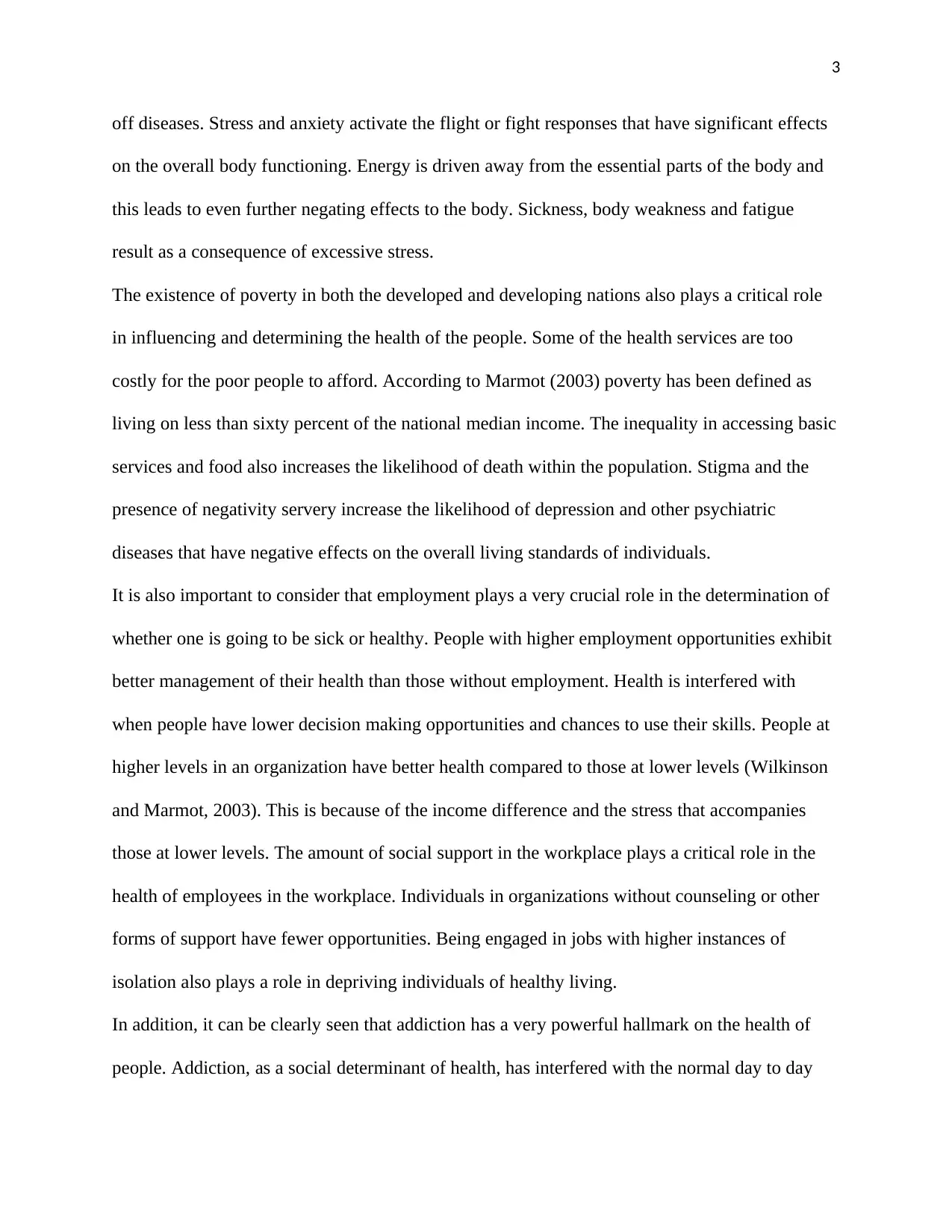
3
off diseases. Stress and anxiety activate the flight or fight responses that have significant effects
on the overall body functioning. Energy is driven away from the essential parts of the body and
this leads to even further negating effects to the body. Sickness, body weakness and fatigue
result as a consequence of excessive stress.
The existence of poverty in both the developed and developing nations also plays a critical role
in influencing and determining the health of the people. Some of the health services are too
costly for the poor people to afford. According to Marmot (2003) poverty has been defined as
living on less than sixty percent of the national median income. The inequality in accessing basic
services and food also increases the likelihood of death within the population. Stigma and the
presence of negativity servery increase the likelihood of depression and other psychiatric
diseases that have negative effects on the overall living standards of individuals.
It is also important to consider that employment plays a very crucial role in the determination of
whether one is going to be sick or healthy. People with higher employment opportunities exhibit
better management of their health than those without employment. Health is interfered with
when people have lower decision making opportunities and chances to use their skills. People at
higher levels in an organization have better health compared to those at lower levels (Wilkinson
and Marmot, 2003). This is because of the income difference and the stress that accompanies
those at lower levels. The amount of social support in the workplace plays a critical role in the
health of employees in the workplace. Individuals in organizations without counseling or other
forms of support have fewer opportunities. Being engaged in jobs with higher instances of
isolation also plays a role in depriving individuals of healthy living.
In addition, it can be clearly seen that addiction has a very powerful hallmark on the health of
people. Addiction, as a social determinant of health, has interfered with the normal day to day
off diseases. Stress and anxiety activate the flight or fight responses that have significant effects
on the overall body functioning. Energy is driven away from the essential parts of the body and
this leads to even further negating effects to the body. Sickness, body weakness and fatigue
result as a consequence of excessive stress.
The existence of poverty in both the developed and developing nations also plays a critical role
in influencing and determining the health of the people. Some of the health services are too
costly for the poor people to afford. According to Marmot (2003) poverty has been defined as
living on less than sixty percent of the national median income. The inequality in accessing basic
services and food also increases the likelihood of death within the population. Stigma and the
presence of negativity servery increase the likelihood of depression and other psychiatric
diseases that have negative effects on the overall living standards of individuals.
It is also important to consider that employment plays a very crucial role in the determination of
whether one is going to be sick or healthy. People with higher employment opportunities exhibit
better management of their health than those without employment. Health is interfered with
when people have lower decision making opportunities and chances to use their skills. People at
higher levels in an organization have better health compared to those at lower levels (Wilkinson
and Marmot, 2003). This is because of the income difference and the stress that accompanies
those at lower levels. The amount of social support in the workplace plays a critical role in the
health of employees in the workplace. Individuals in organizations without counseling or other
forms of support have fewer opportunities. Being engaged in jobs with higher instances of
isolation also plays a role in depriving individuals of healthy living.
In addition, it can be clearly seen that addiction has a very powerful hallmark on the health of
people. Addiction, as a social determinant of health, has interfered with the normal day to day
⊘ This is a preview!⊘
Do you want full access?
Subscribe today to unlock all pages.

Trusted by 1+ million students worldwide
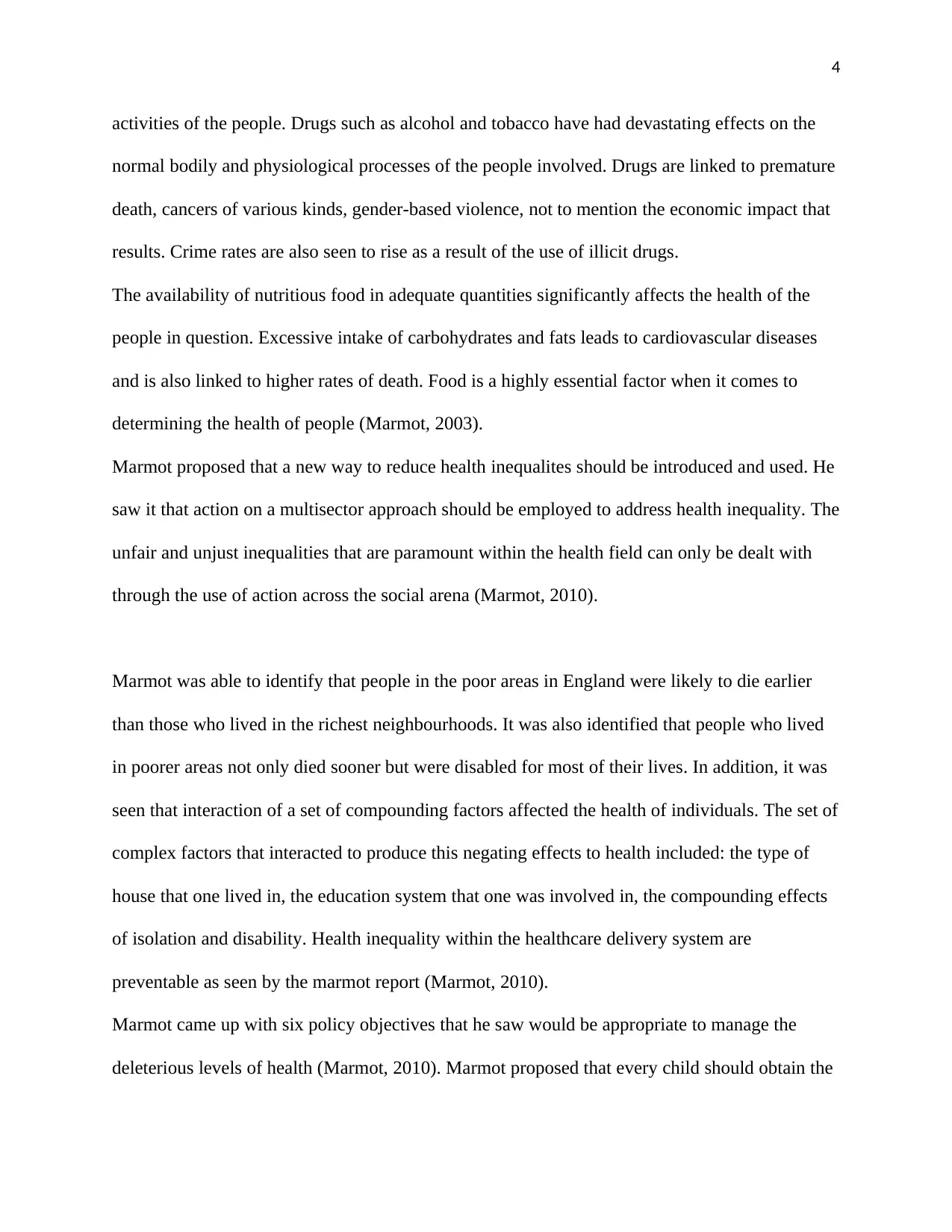
4
activities of the people. Drugs such as alcohol and tobacco have had devastating effects on the
normal bodily and physiological processes of the people involved. Drugs are linked to premature
death, cancers of various kinds, gender-based violence, not to mention the economic impact that
results. Crime rates are also seen to rise as a result of the use of illicit drugs.
The availability of nutritious food in adequate quantities significantly affects the health of the
people in question. Excessive intake of carbohydrates and fats leads to cardiovascular diseases
and is also linked to higher rates of death. Food is a highly essential factor when it comes to
determining the health of people (Marmot, 2003).
Marmot proposed that a new way to reduce health inequalites should be introduced and used. He
saw it that action on a multisector approach should be employed to address health inequality. The
unfair and unjust inequalities that are paramount within the health field can only be dealt with
through the use of action across the social arena (Marmot, 2010).
Marmot was able to identify that people in the poor areas in England were likely to die earlier
than those who lived in the richest neighbourhoods. It was also identified that people who lived
in poorer areas not only died sooner but were disabled for most of their lives. In addition, it was
seen that interaction of a set of compounding factors affected the health of individuals. The set of
complex factors that interacted to produce this negating effects to health included: the type of
house that one lived in, the education system that one was involved in, the compounding effects
of isolation and disability. Health inequality within the healthcare delivery system are
preventable as seen by the marmot report (Marmot, 2010).
Marmot came up with six policy objectives that he saw would be appropriate to manage the
deleterious levels of health (Marmot, 2010). Marmot proposed that every child should obtain the
activities of the people. Drugs such as alcohol and tobacco have had devastating effects on the
normal bodily and physiological processes of the people involved. Drugs are linked to premature
death, cancers of various kinds, gender-based violence, not to mention the economic impact that
results. Crime rates are also seen to rise as a result of the use of illicit drugs.
The availability of nutritious food in adequate quantities significantly affects the health of the
people in question. Excessive intake of carbohydrates and fats leads to cardiovascular diseases
and is also linked to higher rates of death. Food is a highly essential factor when it comes to
determining the health of people (Marmot, 2003).
Marmot proposed that a new way to reduce health inequalites should be introduced and used. He
saw it that action on a multisector approach should be employed to address health inequality. The
unfair and unjust inequalities that are paramount within the health field can only be dealt with
through the use of action across the social arena (Marmot, 2010).
Marmot was able to identify that people in the poor areas in England were likely to die earlier
than those who lived in the richest neighbourhoods. It was also identified that people who lived
in poorer areas not only died sooner but were disabled for most of their lives. In addition, it was
seen that interaction of a set of compounding factors affected the health of individuals. The set of
complex factors that interacted to produce this negating effects to health included: the type of
house that one lived in, the education system that one was involved in, the compounding effects
of isolation and disability. Health inequality within the healthcare delivery system are
preventable as seen by the marmot report (Marmot, 2010).
Marmot came up with six policy objectives that he saw would be appropriate to manage the
deleterious levels of health (Marmot, 2010). Marmot proposed that every child should obtain the
Paraphrase This Document
Need a fresh take? Get an instant paraphrase of this document with our AI Paraphraser
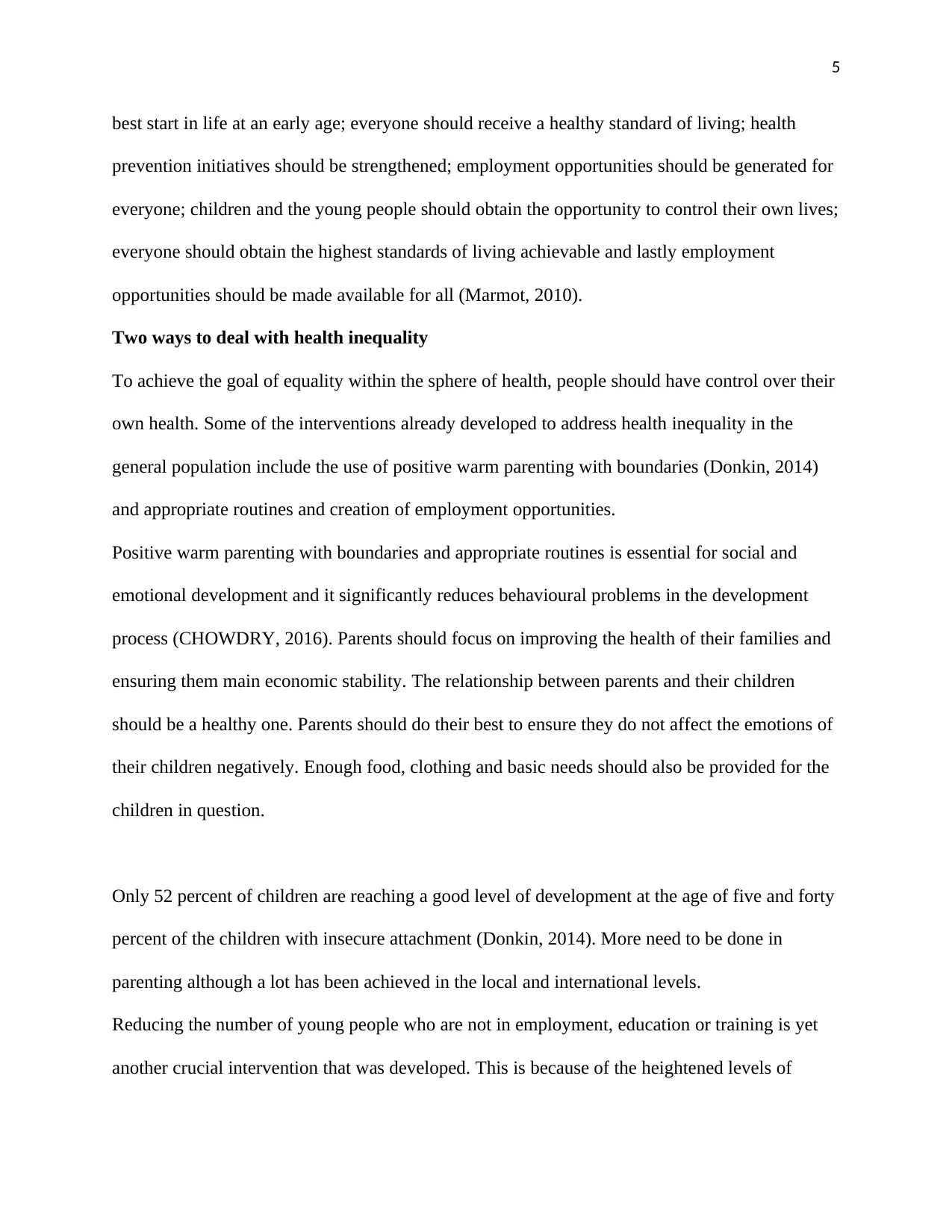
5
best start in life at an early age; everyone should receive a healthy standard of living; health
prevention initiatives should be strengthened; employment opportunities should be generated for
everyone; children and the young people should obtain the opportunity to control their own lives;
everyone should obtain the highest standards of living achievable and lastly employment
opportunities should be made available for all (Marmot, 2010).
Two ways to deal with health inequality
To achieve the goal of equality within the sphere of health, people should have control over their
own health. Some of the interventions already developed to address health inequality in the
general population include the use of positive warm parenting with boundaries (Donkin, 2014)
and appropriate routines and creation of employment opportunities.
Positive warm parenting with boundaries and appropriate routines is essential for social and
emotional development and it significantly reduces behavioural problems in the development
process (CHOWDRY, 2016). Parents should focus on improving the health of their families and
ensuring them main economic stability. The relationship between parents and their children
should be a healthy one. Parents should do their best to ensure they do not affect the emotions of
their children negatively. Enough food, clothing and basic needs should also be provided for the
children in question.
Only 52 percent of children are reaching a good level of development at the age of five and forty
percent of the children with insecure attachment (Donkin, 2014). More need to be done in
parenting although a lot has been achieved in the local and international levels.
Reducing the number of young people who are not in employment, education or training is yet
another crucial intervention that was developed. This is because of the heightened levels of
best start in life at an early age; everyone should receive a healthy standard of living; health
prevention initiatives should be strengthened; employment opportunities should be generated for
everyone; children and the young people should obtain the opportunity to control their own lives;
everyone should obtain the highest standards of living achievable and lastly employment
opportunities should be made available for all (Marmot, 2010).
Two ways to deal with health inequality
To achieve the goal of equality within the sphere of health, people should have control over their
own health. Some of the interventions already developed to address health inequality in the
general population include the use of positive warm parenting with boundaries (Donkin, 2014)
and appropriate routines and creation of employment opportunities.
Positive warm parenting with boundaries and appropriate routines is essential for social and
emotional development and it significantly reduces behavioural problems in the development
process (CHOWDRY, 2016). Parents should focus on improving the health of their families and
ensuring them main economic stability. The relationship between parents and their children
should be a healthy one. Parents should do their best to ensure they do not affect the emotions of
their children negatively. Enough food, clothing and basic needs should also be provided for the
children in question.
Only 52 percent of children are reaching a good level of development at the age of five and forty
percent of the children with insecure attachment (Donkin, 2014). More need to be done in
parenting although a lot has been achieved in the local and international levels.
Reducing the number of young people who are not in employment, education or training is yet
another crucial intervention that was developed. This is because of the heightened levels of
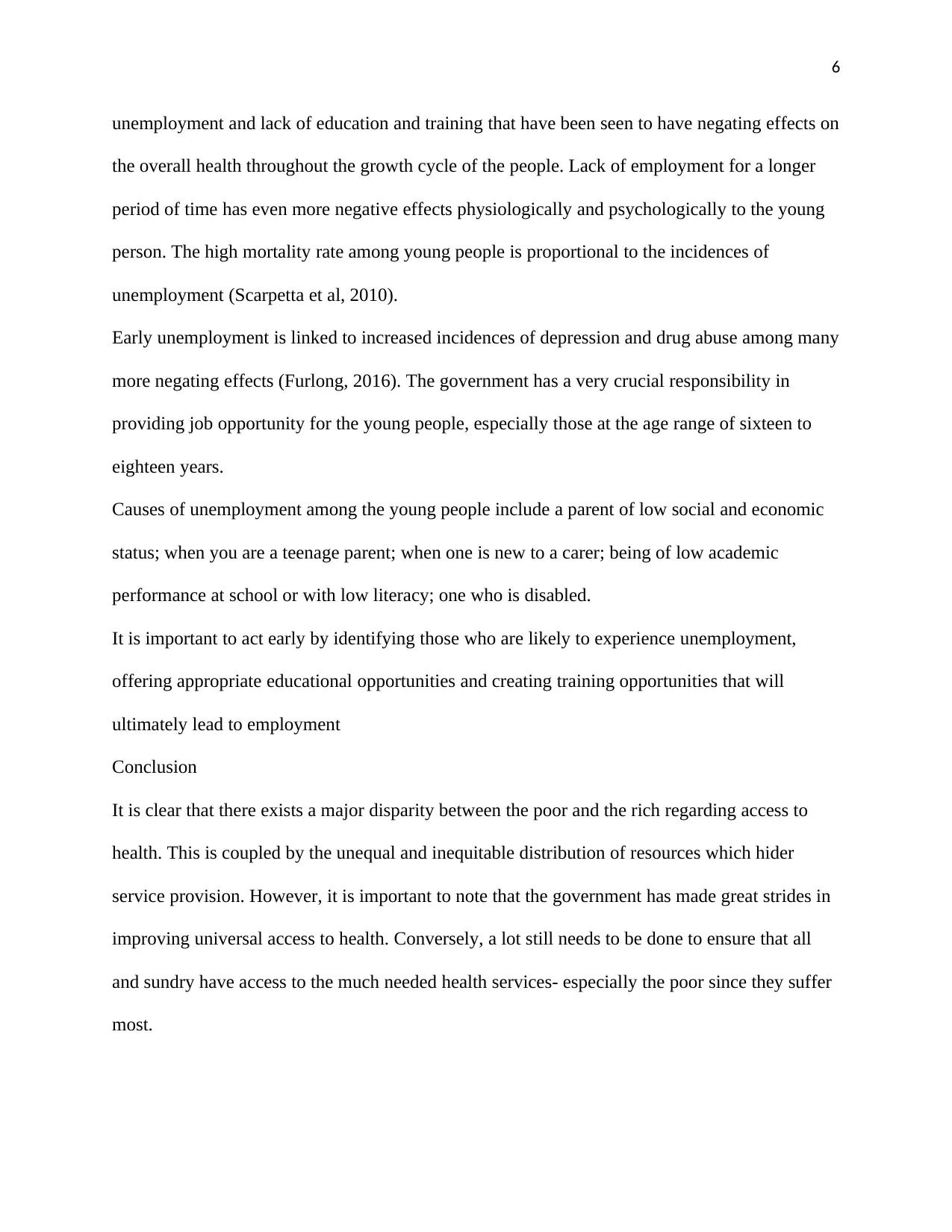
6
unemployment and lack of education and training that have been seen to have negating effects on
the overall health throughout the growth cycle of the people. Lack of employment for a longer
period of time has even more negative effects physiologically and psychologically to the young
person. The high mortality rate among young people is proportional to the incidences of
unemployment (Scarpetta et al, 2010).
Early unemployment is linked to increased incidences of depression and drug abuse among many
more negating effects (Furlong, 2016). The government has a very crucial responsibility in
providing job opportunity for the young people, especially those at the age range of sixteen to
eighteen years.
Causes of unemployment among the young people include a parent of low social and economic
status; when you are a teenage parent; when one is new to a carer; being of low academic
performance at school or with low literacy; one who is disabled.
It is important to act early by identifying those who are likely to experience unemployment,
offering appropriate educational opportunities and creating training opportunities that will
ultimately lead to employment
Conclusion
It is clear that there exists a major disparity between the poor and the rich regarding access to
health. This is coupled by the unequal and inequitable distribution of resources which hider
service provision. However, it is important to note that the government has made great strides in
improving universal access to health. Conversely, a lot still needs to be done to ensure that all
and sundry have access to the much needed health services- especially the poor since they suffer
most.
unemployment and lack of education and training that have been seen to have negating effects on
the overall health throughout the growth cycle of the people. Lack of employment for a longer
period of time has even more negative effects physiologically and psychologically to the young
person. The high mortality rate among young people is proportional to the incidences of
unemployment (Scarpetta et al, 2010).
Early unemployment is linked to increased incidences of depression and drug abuse among many
more negating effects (Furlong, 2016). The government has a very crucial responsibility in
providing job opportunity for the young people, especially those at the age range of sixteen to
eighteen years.
Causes of unemployment among the young people include a parent of low social and economic
status; when you are a teenage parent; when one is new to a carer; being of low academic
performance at school or with low literacy; one who is disabled.
It is important to act early by identifying those who are likely to experience unemployment,
offering appropriate educational opportunities and creating training opportunities that will
ultimately lead to employment
Conclusion
It is clear that there exists a major disparity between the poor and the rich regarding access to
health. This is coupled by the unequal and inequitable distribution of resources which hider
service provision. However, it is important to note that the government has made great strides in
improving universal access to health. Conversely, a lot still needs to be done to ensure that all
and sundry have access to the much needed health services- especially the poor since they suffer
most.
⊘ This is a preview!⊘
Do you want full access?
Subscribe today to unlock all pages.

Trusted by 1+ million students worldwide
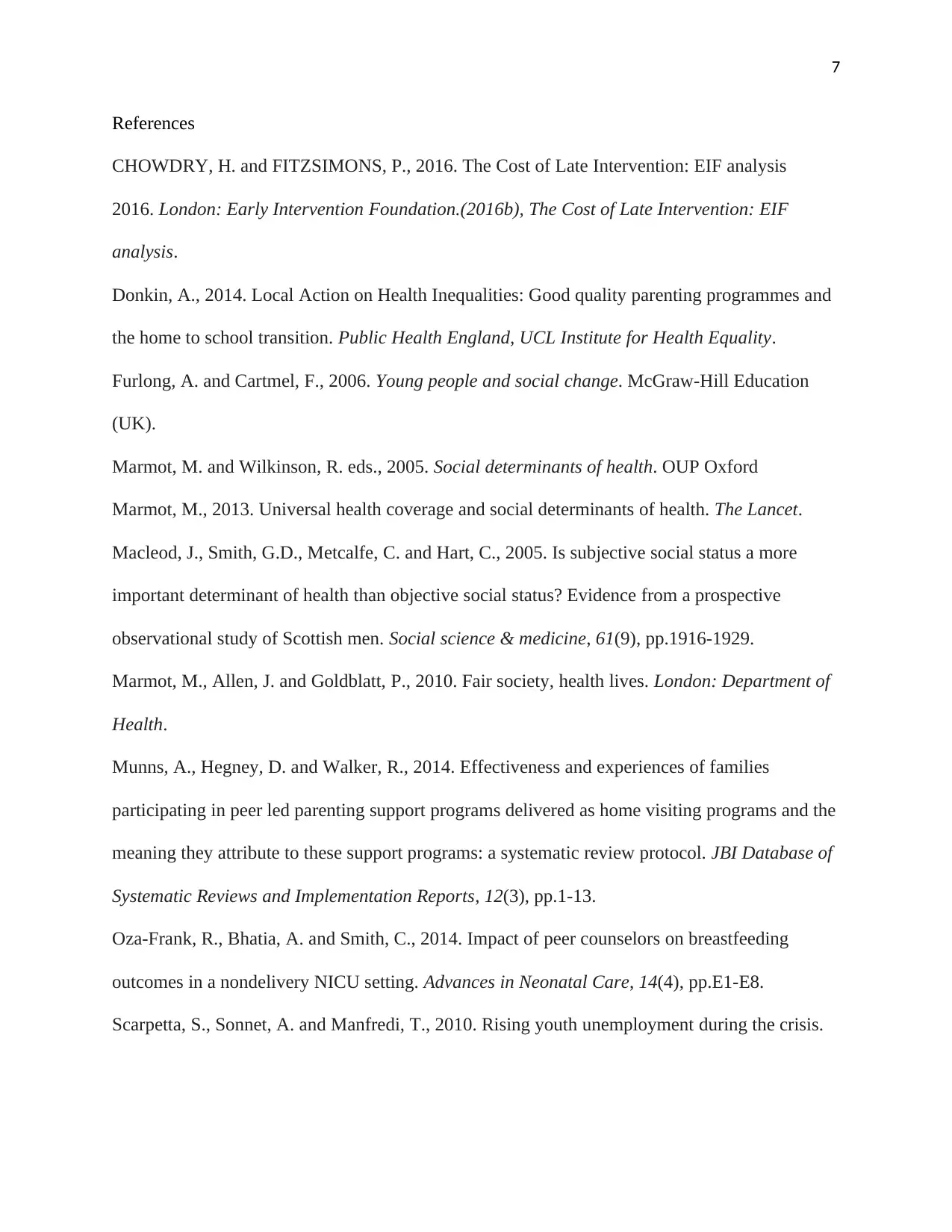
7
References
CHOWDRY, H. and FITZSIMONS, P., 2016. The Cost of Late Intervention: EIF analysis
2016. London: Early Intervention Foundation.(2016b), The Cost of Late Intervention: EIF
analysis.
Donkin, A., 2014. Local Action on Health Inequalities: Good quality parenting programmes and
the home to school transition. Public Health England, UCL Institute for Health Equality.
Furlong, A. and Cartmel, F., 2006. Young people and social change. McGraw-Hill Education
(UK).
Marmot, M. and Wilkinson, R. eds., 2005. Social determinants of health. OUP Oxford
Marmot, M., 2013. Universal health coverage and social determinants of health. The Lancet.
Macleod, J., Smith, G.D., Metcalfe, C. and Hart, C., 2005. Is subjective social status a more
important determinant of health than objective social status? Evidence from a prospective
observational study of Scottish men. Social science & medicine, 61(9), pp.1916-1929.
Marmot, M., Allen, J. and Goldblatt, P., 2010. Fair society, health lives. London: Department of
Health.
Munns, A., Hegney, D. and Walker, R., 2014. Effectiveness and experiences of families
participating in peer led parenting support programs delivered as home visiting programs and the
meaning they attribute to these support programs: a systematic review protocol. JBI Database of
Systematic Reviews and Implementation Reports, 12(3), pp.1-13.
Oza-Frank, R., Bhatia, A. and Smith, C., 2014. Impact of peer counselors on breastfeeding
outcomes in a nondelivery NICU setting. Advances in Neonatal Care, 14(4), pp.E1-E8.
Scarpetta, S., Sonnet, A. and Manfredi, T., 2010. Rising youth unemployment during the crisis.
References
CHOWDRY, H. and FITZSIMONS, P., 2016. The Cost of Late Intervention: EIF analysis
2016. London: Early Intervention Foundation.(2016b), The Cost of Late Intervention: EIF
analysis.
Donkin, A., 2014. Local Action on Health Inequalities: Good quality parenting programmes and
the home to school transition. Public Health England, UCL Institute for Health Equality.
Furlong, A. and Cartmel, F., 2006. Young people and social change. McGraw-Hill Education
(UK).
Marmot, M. and Wilkinson, R. eds., 2005. Social determinants of health. OUP Oxford
Marmot, M., 2013. Universal health coverage and social determinants of health. The Lancet.
Macleod, J., Smith, G.D., Metcalfe, C. and Hart, C., 2005. Is subjective social status a more
important determinant of health than objective social status? Evidence from a prospective
observational study of Scottish men. Social science & medicine, 61(9), pp.1916-1929.
Marmot, M., Allen, J. and Goldblatt, P., 2010. Fair society, health lives. London: Department of
Health.
Munns, A., Hegney, D. and Walker, R., 2014. Effectiveness and experiences of families
participating in peer led parenting support programs delivered as home visiting programs and the
meaning they attribute to these support programs: a systematic review protocol. JBI Database of
Systematic Reviews and Implementation Reports, 12(3), pp.1-13.
Oza-Frank, R., Bhatia, A. and Smith, C., 2014. Impact of peer counselors on breastfeeding
outcomes in a nondelivery NICU setting. Advances in Neonatal Care, 14(4), pp.E1-E8.
Scarpetta, S., Sonnet, A. and Manfredi, T., 2010. Rising youth unemployment during the crisis.
Paraphrase This Document
Need a fresh take? Get an instant paraphrase of this document with our AI Paraphraser
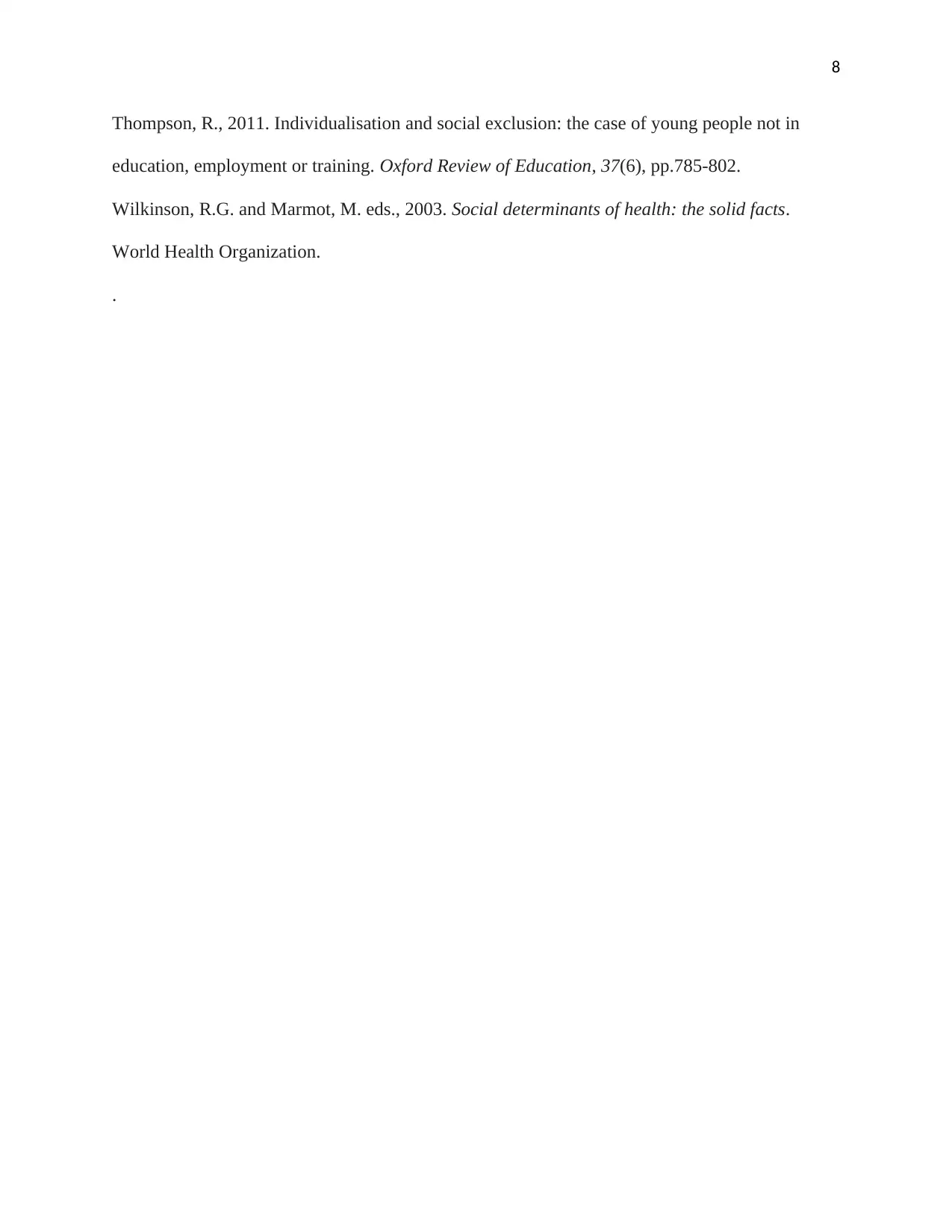
8
Thompson, R., 2011. Individualisation and social exclusion: the case of young people not in
education, employment or training. Oxford Review of Education, 37(6), pp.785-802.
Wilkinson, R.G. and Marmot, M. eds., 2003. Social determinants of health: the solid facts.
World Health Organization.
.
Thompson, R., 2011. Individualisation and social exclusion: the case of young people not in
education, employment or training. Oxford Review of Education, 37(6), pp.785-802.
Wilkinson, R.G. and Marmot, M. eds., 2003. Social determinants of health: the solid facts.
World Health Organization.
.
1 out of 8
Related Documents
Your All-in-One AI-Powered Toolkit for Academic Success.
+13062052269
info@desklib.com
Available 24*7 on WhatsApp / Email
![[object Object]](/_next/static/media/star-bottom.7253800d.svg)
Unlock your academic potential
Copyright © 2020–2025 A2Z Services. All Rights Reserved. Developed and managed by ZUCOL.




